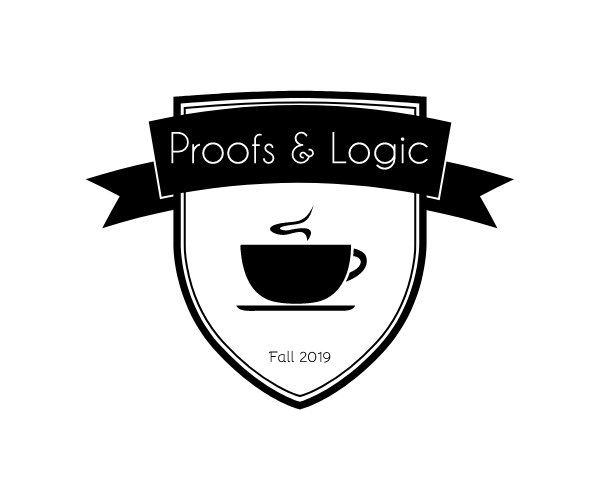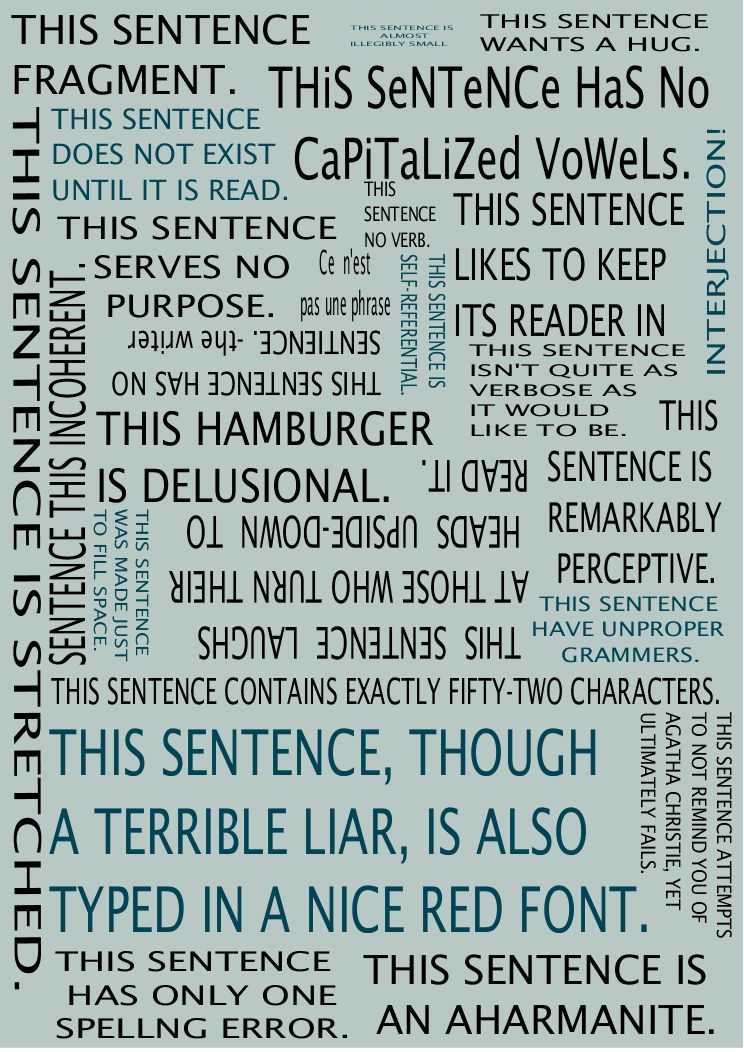Due Thursday, 9/19/19. For this week’s writing assignment, take a look at the picture below called “Sentences.” Read every sentence in the picture. As you read, pay attention to your own stream of consciousness – what are the thoughts that pop into your head? For full credit, respond to all 4 of the following items.
- Record two observations about the sentences in the picture – what do you notice / what’s something you find interesting / what popped into your head / what stood out.
- Choose one of the sentences in the picture (do NOT choose the same sentence as anyone else). Type the sentence out “in quotes”, and then answer the following questions:
a. Is it a statement (as discussed in class)? Explain why or why not.
b. Is it true or false? Explain in everyday English why or why not. - Make up a sentence that you believe would fit into this picture. Tell us the sentence, and then tell us whether it is a statement, and whether it is true or false.
- What connection (if any) does this assignment have to do with the work we are doing in class?





1. The sentences in the picture are very random. Some sentences make little to no sense and others have a humorous element to them. Just as one may think they have read all the sentences, there seems to be one more that pops up.
2. “This sentence has only one spellng error.”
a. This sentence is a statement because it can be answered with “true”, or “false.”
b. This sentence is true. This sentence is true because it only has one spelling error; the word “spelling,” is incorrectly spelled as “spellng.” If there were no spelling errors or more than one spelling error, the sentence would be false.
3. “This sentence is a Queen.”
The sentence above is a statement because its validity or falsehood can be proven. The sentence is in fact false because sentences cannot be queens.
4. In class we are learning about what a statement is. We are also learning about the different way’s statements can be connected (conditional, conjunction, disjunction). This exercise aims to help students in the course properly identify and understand statements.
Great analysis. I love your example #3!
1. The sentences are trolling me and are very factual.
2. “THIS SENTENCE DOES NOT EXIST UNTIL IT IS READ” This is a statement because it can be true or false. This is true because by reading it, it came into my existence at the very least.
3. This sentence is the answer you wanted.
Awesome. Your sentence 3 made me laugh, and think – I can’t decide if it is true or not! If, in fact, it IS the answer I wanted, then it’s true. If it’s NOT the answer I wanted, then it’s false. Did I want that answer? I’m not sure what I wanted, but I like it!
ps. Complete part 4 (What connection (if any) does this assignment have to do with the work we are doing in class?) for full credit (just leave a comment with your response to 4).
4. This connects with our class work because it helps us get used to sentences that are not usually said so we can identify statements.
P.S: I had more to my problem 3 and I did problem 4. I think it got deleted somehow, but it’s just a heads up.
1. The sentences were very funny. I read them all and could not help but agree or disagree with some of them.
2. “This sentence is almost illegibly small” I think it is a statement, because it can be true or false. And I think it is true because I struggled to read it.
3.”thIs sEntEncE hAs All vOwEls cApItAlIzEd” This sentence is a true statement.
4.This connects with our class work because we get to tell the difference between sentences that are statements and those that are not.
1) To answer the first question, something I found interesting was the french somewhere in the middle. It stood out to me I can understand it enough to decipher what it says. Another thing I noticed that for the incomplete sentences, my head automatically filled it in my mind and read it as a complete sentence. Such as “this setence no verb”. My brain automatically filled in “has”.
2) “This sentence, though a terrible liar, is typed in a nice red font”
a) This is a statement because it can be proven true or false.
b)It is a false statement because it was typed in a teal font (at least I think it’s teal)
3) “This sentence needs a period”
This statement is true because to end every sentence, a period must be at the end.
4) This assignment helps us understand what would be considered a statement and allows us to attempt to make our own valid statement based on what we learned in class about what makes a statement a statement.
1. Something I found interesting in this picture is the sentences seem like disorder or look unusual, but I can read the sentence from the picture. One thing pooped into my head was the picture look like an advertising slogan; telling me the definition of sentences.
2. ” sentence this incoherent.”
a. This is a statement because it can be proven true or false.
b. This is true because this sentence is incoherent and hard to understand.The correct should be -This sentence incoherent.
3. “This sentence has its meaning.” I think it is a statement because different people have their understanding of this sentence. This statement is false because it doesn’t say what its meaning is.
4.We talked about what is statement and how to proven it is true or false in class. This assignment help me have better comprehend of statement.